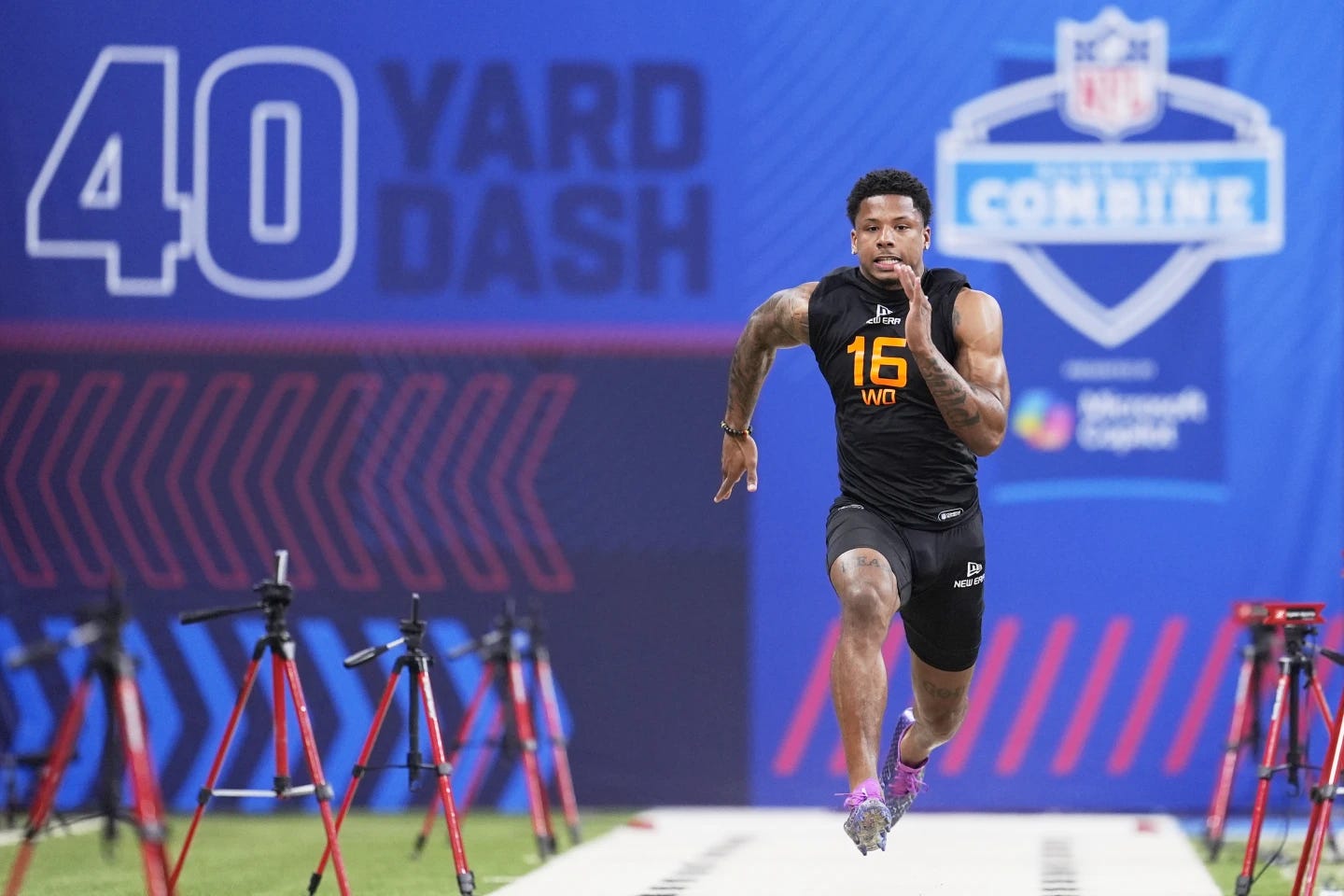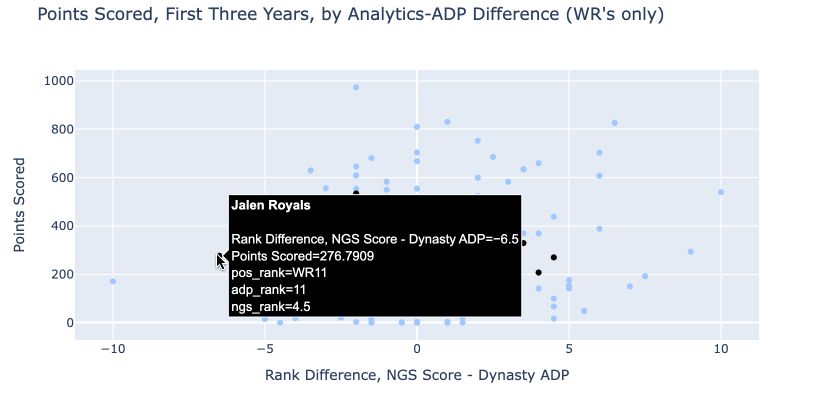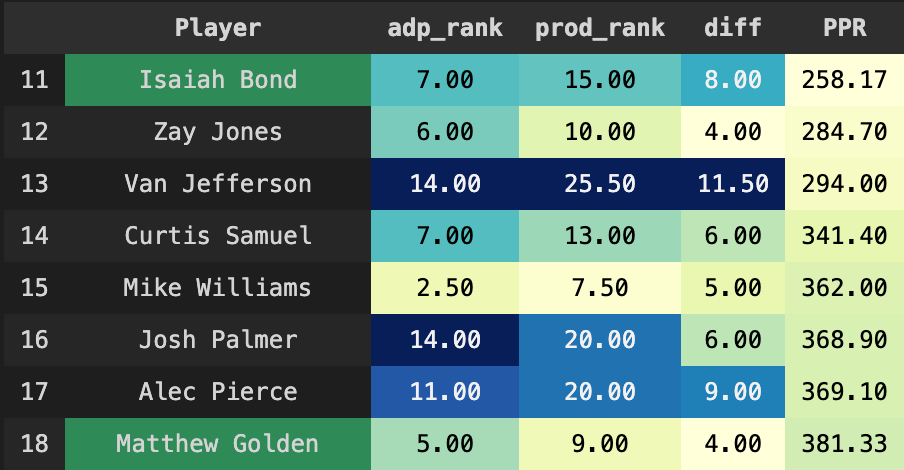Fantasy Players vs. AI, pt. 2: Receivers
Are disagreements between analytical models & receiver draft position predictive?
Earlier this week, I explored whether disagreements between average draft position (ADP) and analytical metrics, like Next Gen Stats’ (NGS) production score, can help explain why running back prospects succeed or fail. Today, I’m examining receivers through a similar lens.
Above is a chart (click to enhance) showing this difference between the analytical model (NGS Score) and the fantasy community (ADP). Notably, I’m using overall NGS Score, and not just the production-based score like I did for running backs. The Combine IQ website claims this production score is better. Yet their overall model—which includes other factors like athleticism—showed a stronger correlation with points scored in my sample (2016-2022 draft classes).
The takeaway, like with running backs, is that ADP is better at predicting star-level success for wide receivers. While many ADP favorites became stars (upper right), NGS picks (left) give us fewer success stories. The dark blue dots represent the 2025 class, affirming the idea that many receivers in the 2025 class have lower ceilings.
When stats are bullish, but the community isn’t
Taking players where the NGS model was higher than consensus, a pattern starts to emerge. Many players above have strong 40 times, perhaps giving us insight into how NGS Score works. The Combine IQ site says 40 time is a “key metric”, meaning it could be more predictive than NGS Score itself (which the site currently ranks fourth).
This may be telling for 2025 prospects Jalen Royals and Jaylin Noel, whom the model likes more than the fantasy community. Both could see their profiles rise by the NFL draft, but there are also similarities to past busts seen above. While they aren’t pure burners like Andy Isabella or Tylan Wallace, speed’s still a big part of their appeal.
There are also questions about how Noel and Royals’ skillsets translate to the NFL. Noel could be a vertical-slot a la Christian Kirk, and is deceptively productive at the catch point. Royals, too, is notably quick, garnering Jayden Reed comps. While those are useful archetypes, each has flaws, too. Analysts have raised physicality concerns for both Noel and Royals, though some have also noted Noel plays well above his size.
What to do with unproductive receivers?
We now bring back NGS production score to examine unproductive college players who were still relevant picks. By sorting to highlight the worst-scoring players, we do miss guys like DK Metcalf and George Pickens, though their success in spite of poor production is more exception than rule. Ultimately, players like Pickens and Metcalf underscore how often it takes a special athlete to overcome poor college production.
But what of Matthew Golden, 18th this on this list, who’s skyrocketing up boards due to his blazing 40 time? It’s harder to parse how he’ll turn out, given how varied the situations were for the busts ahead of him. A common thread is injury: Mims, Hamler, and Edwards saw collegiate injury issues persist into the NFL. Golden might fit in this bucket, having missed substantial time in his first two college seasons.
Notably, his college production was also much better than the other names on this list. It’s worth noting his early-entrant status could help excuse away his low production, too. The most likely case is his NFL production matches his profile, one of a good secondary option to a strong #1 receiver (a common refrain with this year’s class).
The outlook isn’t so sunny for his teammate Isaiah Bond, however, with the worst production of the 2025 class. Now infamous for bragging he’d run his 40-yard dash in 4.2 seconds—and falling far short of that—Bond’s athletic profile accordingly suffers, with NGS grading him as a good, but not exceptional athlete. Add in character concerns, and the parallels between him and the biggest low-production busts are extremely disconcerting. He checks nearly every box, really, by being a speed-first player with personality questions and a worrisome injury history.
The 2025 class
Above are the three-year outlooks for the 2025 receiver class. Notably, the NGS model and ADP are generally in accord on this class, and will likely agree even more the closer we get to draft time. Expect Xavier Restrepo and Isaiah Bond, for example, to drop further down fantasy boards after the draft, based on underwhelming testing.
Again, this matches the impression of this class, with few players exhibiting elite potential. There are real questions about how these guys’ skillsets will map to the NFL, a far more unforgiving environment than college.
Beyond players already discussed, Tre Harris and Jayden Higgins stand out. The model likes Higgins more than consensus, while it’s relatively lower on Harris. Even still, it’s easy to imagine either of these players having their name called first on draft night, underscoring just how closely grouped this class is in talent.
Finally, it’s worth shouting out Travis Hunter, whom the NGS model adores. Per NGS, he’s the clear top receiving prospect, a view shared by Reception Perception’s Matt Harmon, who sees Hunter as a real WR1 in a field of likely WR2’s. It’s also worth noting that the comprehensive NGS model is sunnier on Matthew Golden than their production-only model, underscoring the potential value of his athleticism.
Summary
Overall, while receiver success is harder to predict than with running backs, there are still a few lessons to be learned:
If you’re picking an unproductive college player, he’d better be an athletic freak
Speed-only receivers are the draft’s biggest pitfall
Injury history matters, and shouldn’t be used to excuse poor production
Like with running backs, age-old fantasy truisms still hold as well. Opportunity matters, as some of the big wins for the NGS model demonstrate, such as the case of Dede Westbrook. Yet Westbrook is really an example of how deceptively hard opportunity is to quantify: nobody could’ve predicted Allen Hurns falling off a cliff, along with Allen Robinson tearing his ACL during Westbrook’s rookie year.
Yet we’re still just barely scratching the surface. I hope to provide further insights in upcoming post about what thresholds receivers must clear to make it in the league. Be sure to check out my past post on Running Backs, and as always, thanks for reading!








